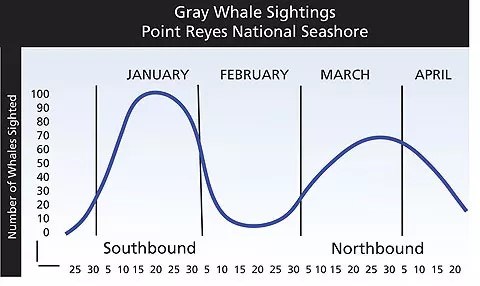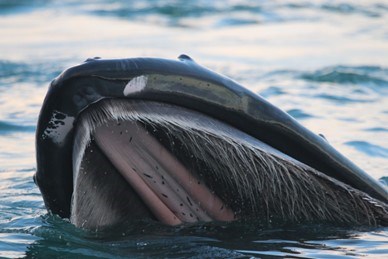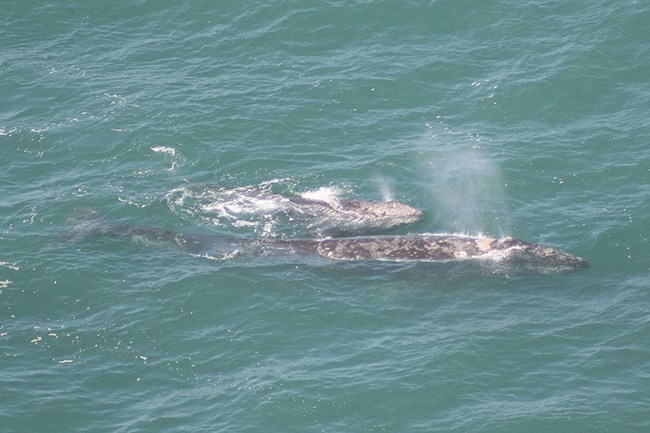
NPS/A. Kopshever 
NPS Photo The Gray Whale is one of the most exciting mammals to see in Point Reyes and are spotted every winter and spring. As these magnificent creatures pass the shores of Point Reyes, they are making one of the most exhausting migrations of any animal—traveling nearly 13,000 miles (20,922 km) round trip! In December and January thousands of whales migrate south past the Point Reyes peninsula. In February sightings at this location slow down, as most whales are already in the warm lagoons of Baja California, Mexico. In March, sightings start to increase again as the whales make their way north to their Alaskan feeding grounds. During the northbound migration, most gray whales are within a mile of the shore. For tips on spotting Gray Whales, among other species, and the best spots to do so in Point Reyes, visit our Whale Watching webpage! 
NPS Photo What are Baleen Whales?Gray whales are baleen whales. Whales have two suborders: baleen whales or toothed whales. Baleen whales do not have bony teeth, instead have overlapping baleen plates. Baleen plates are hair-like "teeth" that hang from the upper jaw of some species of whales. Baleen is made of keratin--just like our hair and fingernails--and has the texture of a broom! Physical AppearanceA gray whale can grow to about 50 feet (15 m) long and weigh up to forty tons. While Gray whales do not have a dorsal fin, they do have dorsal hump. A series of 8 to 14 small bumps called "knuckles" follow the dorsal hump. When whale-watching you will see the spout as the whale surfaces to breathe, then its back as it dives beneath the surface. Look closely at its back, and you can identify the species by the shape of the dorsal fin or hump. Calves are born a uniform dark gray that becomes spotted as they get older. The spots are scars left when barnacles that live on the whales head and tail break off. The gray whale and the barnacles that live on them are an excellent example of commensalism. Commensalism is a relationship where one organism benefits, and the other doesn't experience any benefits or drawbacks. Gray whales can also have whale lice, which behave more like a true parasite. These whale lice feed on the whale's skin and tissue, and while this does not harm the whale, it appaears that it does become irritating after a while. One theory is that gray whales breach, jumping fully out of the water, to knock off the irritating whale lice. 
NOAA Fisheries Illustration Reproduction and Life SpanMigration ensures the survival of gray whales. They travel to the warm water lagoons in Mexico to give birth and to mate. Gray whales reach breeding age at approximately eight years of age. Females may mate with several males and will become pregnant once every two or more years. During a gray whale's year-long gestation period, the female will have migrated from Mexico to Alaska and back. Baby whales are called calves, and the warm lagoons of Baja are a safe place to be born, sometimes with the help of a whale “auntie.” Calves are born with rubbery flippers, making swimming immediately after birth difficult. Since the calf cannot swim, the mother or auntie will push the calf to the surface for their first breath. The calf is 12 to 15 feet (3.5 to 4.5 m) long at birth, weighing up to1,500 pounds (680kg), about a third of the size of an adult. Calves nurse for seven to eight months. Gray whale mothers produce milk that is 53% fat, compared to human milk which is 3-5% fat. Calves will drink up to 50 gallons of milk a day, gaining 60-70 pounds of blubber daily. Having a thick layer of blubber will be necessary for their northern migration into artic waters. Reproduction success, and low infant mortality, is necessary for the gray whale population. Gray whales are currently experiencing an unusual mortality event (UME), which began in 2019. The UME is causing younger whales to become stranded, with no clear cause of death. Under normal circumstances, gray whales can live up to seventy years. 
NPS Photo Conservation EffortsIn the early 1900s, citizens became concerned about waning biodiversity, especially among ocean species. Humans hunted some whale species to extinction in the quest for their oil-rich blubber used for machine lubrication and oil lamps. Fortunately over time, conservation groups pressured their governments to institute protective measures. In 1949, the International Whaling Commission banned commercial hunting of gray whales. In 1971, the Mexican government protected breeding lagoons in Baja. This legislation created the first whale sanctuary in the world. The United States expanded protection for marine life by establishing the Marine Mammal Protection act in 1972. Gray whales were also protected by the Endangered Species Act of 1973. The protected gray whale population in the eastern Pacific began to grow. The U.S. Fish and Wildlife Service delisted gray whales from the endangered species list in 1994. Current ThreatsGray whales have made a remarkable recovery from the brink of extinction. Yet, there are still many issues that may affect the future of the whales. Threats include:
Given how human activitiy impacts marine mammals like gray whales, our choices and decisions have a profound influence on their future. Learn more about the National Park Service’s response to climate change. Read More about Gray WhalesPhoto Gallery |
Last updated: August 19, 2023
